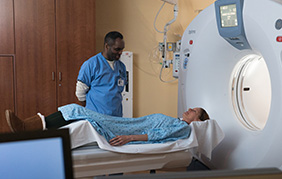Radiation therapy options
Radiation therapy is treatment that uses high-energy X-rays to destroy cancer cells. This therapy may be used in several situations: After breast-conserving surgery, after a mastectomy or if cancer has spread to other parts of the body.
Radiation therapy is used after surgery to kill remaining cancer cells and help prevent recurrence. It may also be used to provide relief from pain and other symptoms of metastatic breast cancer (cancer that has spread to other parts of the body).
Some of the many radiation therapies City of Hope offers to breast cancer patients include:
External beam radiation therapy (EBRT)
The most common type of radiation therapy for breast cancer, EBRT usually given about a month after surgery. EBRT is fast, painless and performed as an outpatient procedure. It is also targeted to the treatment area including the spot where cancer was removed. It may also be delivered to nearby lymph nodes. Two methods of using EBRT to treat breast cancer are:
Accelerated partial breast irradiation for breast cancer (APBI): APBI is a breast radiation therapy in which focused radiation is delivered specifically to the part of the breast where the tumor was removed. This therapy allows radiation to be contained to the tumor cavity as much as possible. Because the radiation is so targeted, it affects less of the healthy tissue and organs close to the breasts, such as the lungs, heart, ribs, muscles and skin. APBI may also be given on a more condensed schedule than some other radiation therapies for breast cancer (five days instead of six to seven weeks).
Whole-breast radiation: If a lumpectomy is performed, EBRT may be used on the entire breast. The standard schedule for whole breast radiation is five days a week for six to seven weeks. Another option is hypofractionated radiation therapy where the radiation is also given to the whole breast but in fewer, larger doses (typically three to four weeks). This schedule has been shown to be as effective at preventing cancer recurrence in the same breast as giving radiation over longer periods of time. It may also lead to fewer short-term side effects.
High-dose rate (HDR) brachytherapy
HDR brachytherapy is a form of internal radiation therapy in which tiny, hollow catheters are temporarily inserted directly into a tumor. A series of radioactive pellets are then inserted into each catheter. By tightly containing radiation within the tumor, this treatment helps reduce radiation exposure to healthy surrounding tissue. Each treatment takes only a few minutes and the entire treatment plan takes one to two days. After a series of treatments, the catheters are removed. No radioactive seeds are left in the body.
Hyperthermia
Hyperthermia (which means “elevated temperature”) damages or destroys cancer cells by raising the temperature of the tumor to a “high fever” range, similar to the way the body uses fever naturally when combating other conditions. Breast cancer hyperthermia helps make breast cancer cells more vulnerable to the effects of other treatments, such as radiation therapy and chemotherapy. City of Hope radiation oncologists may use hyperthermia to treat superficial breast tumors located within a few centimeters beneath the surface of the body.
Intensity modulated radiation (IMRT)
IMRT is a state-of-the-art radiation delivery system used to treat difficult-to-reach tumors. Using advanced software to plan a precise dose of radiation, based on tumor size, shape and location, a computer-controlled device delivers radiation in sculpted doses that match the exact 3D geometrical shape of the tumor. IMRT may be an appropriate treatment if you have previously had conventional radiation therapy and are experiencing recurrent tumors in the treated area.
Intraoperative radiation therapy (IORT)
IORT delivers a concentrated dose of radiation therapy to a tumor bed during surgery. This technology may help kill microscopic disease, reduce radiation treatment times and provide an added radiation boost. IORT is performed immediately following the removal of a breast lump and before the lumpectomy incision is closed. This treatment is generally reserved for patients with early-stage disease.
MammoSite® radiation therapy system (RTS)
MammoSite RTS is an innovative form of brachytherapy targeted specifically for breast cancer treatment. This therapy involves placing radioactive seeds (pellets) directly into the area where a tumor has been surgically removed via lumpectomy. While standard breast brachytherapy involves surgically implanting up to 24 catheters into the breast, MammoSite RTS calls for just a single balloon catheter. With its precise, site-specific approach, this therapy can be completed in four to five days.
TomoTherapy®
TomoTherapy combines an advanced form of IMRT with an onboard CT scanner that allows for advanced and precise targeting of radiation. While traditional radiation therapies project radiation onto a tumor from a few directions, TomoTherapy delivers precise doses of radiation to tumors through a 360-degree delivery pattern. TomoTherapy may be a promising option if you have advanced stage or recurrent cancer and are no longer able to receive traditional radiation.
TrueBeam®
The TrueBeam® software and respiratory tracking system enables us to confirm the location of the breast tumor, track its movement and help avoid damage to healthy surrounding tissue. A tumor in the breast can move as you breath, making it difficult to target accurately with standard radiation. As a result, the tumor may not receive enough radiation and healthy tissue near the tumor may be damaged.
